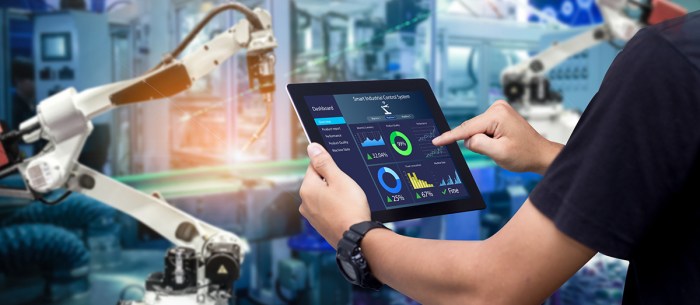
The modern business landscape is increasingly reliant on efficient and resilient supply chains. Supply chain automation, the integration of technology to streamline and optimize various stages of the supply chain, is no longer a futuristic concept but a crucial element for competitiveness and profitability. This guide delves into the core aspects of supply chain automation, exploring its benefits, challenges, and future implications for businesses of all sizes.
From automating procurement processes to leveraging AI-powered predictive analytics, this exploration will examine the diverse technological solutions available and their impact on key performance indicators (KPIs) such as inventory management, order fulfillment, and overall operational efficiency. We will also consider the broader context, including the ethical considerations and the evolving role of the workforce in an increasingly automated environment.
Supply Chain Visibility and Data Analytics
Automation significantly transforms supply chain visibility and efficiency, providing unprecedented access to real-time data and insights. This enhanced visibility allows for proactive issue resolution, optimized resource allocation, and ultimately, improved profitability. The integration of automation technologies with data analytics tools unlocks the potential for data-driven decision-making, moving away from reactive problem-solving towards a more strategic and predictive approach.
Enhanced Visibility and Data Collection through Automation
Automation technologies, such as RFID tracking, IoT sensors, and advanced warehouse management systems (WMS), dramatically improve data collection across the entire supply chain. Real-time tracking of goods from origin to delivery generates a comprehensive dataset encompassing location, time, and condition. This detailed information replaces the reliance on manual data entry and estimations, resulting in more accurate and reliable data for analysis.
For example, real-time tracking of temperature-sensitive goods ensures that products remain within optimal conditions throughout the supply chain, preventing spoilage and reducing waste. Automated data capture reduces human error, leading to a more accurate and reliable representation of supply chain activities.
Data Analytics for Supply Chain Optimization
Data analytics plays a crucial role in leveraging the wealth of information generated by automated systems. By applying advanced analytical techniques like machine learning and predictive modeling, businesses can identify patterns, predict potential disruptions, and optimize various aspects of their supply chain. For instance, analyzing historical sales data coupled with real-time inventory levels can predict future demand, enabling proactive adjustments to production and inventory management.
Predictive maintenance, based on sensor data from automated equipment, allows for timely repairs, minimizing downtime and production disruptions. This proactive approach significantly reduces costs and improves overall efficiency.
Real-time Data and Improved Decision-Making
The availability of real-time data through automation enables immediate responses to unexpected events. For example, if a shipment is delayed due to unforeseen circumstances, the system can immediately alert relevant stakeholders, allowing them to initiate contingency plans and mitigate potential disruptions. Real-time visibility into inventory levels prevents stockouts and minimizes the risk of lost sales. This rapid response capability, driven by real-time data, allows for more informed and effective decision-making, minimizing disruptions and improving overall supply chain resilience.
The ability to react swiftly and decisively based on accurate, up-to-the-minute information significantly reduces the impact of unexpected events.
Supply Chain Metrics Dashboard
The following dashboard illustrates key supply chain metrics made visible through automation:
| Metric | Current Value | Target Value | Status |
|---|---|---|---|
| On-Time Delivery Rate | 95% | 98% | Meeting Target |
| Inventory Turnover Rate | 6.2 | 7.0 | Below Target |
| Order Fulfillment Cycle Time | 2 days | 1.5 days | Above Target |
| Total Supply Chain Cost | $1,200,000 | $1,100,000 | Above Target |
The Future of Supply Chain Automation
The relentless pursuit of efficiency and resilience is driving the evolution of supply chain automation. Emerging technologies are rapidly transforming how goods are sourced, produced, and delivered, promising a future characterized by greater speed, accuracy, and responsiveness. This shift, however, presents both exciting opportunities and significant challenges for businesses and the workforce.
Emerging Trends and Technologies
Several key technologies are shaping the future of supply chain automation. Artificial intelligence (AI) is rapidly becoming a cornerstone, powering predictive analytics for demand forecasting, optimizing logistics routes, and automating quality control processes. Machine learning algorithms, a subset of AI, continuously learn and improve their performance, leading to increasingly sophisticated automation capabilities. Robotics, particularly in warehousing and manufacturing, is automating repetitive tasks, increasing throughput, and reducing human error.
The Internet of Things (IoT), with its network of interconnected devices, provides real-time visibility into every stage of the supply chain, enabling proactive intervention and optimized resource allocation. Blockchain technology offers enhanced security and transparency by providing an immutable record of transactions, crucial for tracking products and ensuring authenticity. Finally, digital twins – virtual representations of physical assets and processes – allow for simulation and optimization before implementation, minimizing risks and maximizing efficiency.
For example, a company could use a digital twin of its warehouse to test different layout configurations and robotic deployments before making physical changes, significantly reducing disruption and cost.
Impact of Automation on Jobs and the Workforce
Automation’s impact on jobs is a complex issue. While some jobs will undoubtedly be displaced by automation, new roles requiring specialized skills in areas like data science, AI management, and robotics maintenance will emerge. The shift will necessitate a focus on reskilling and upskilling the workforce to adapt to these evolving demands. For instance, warehouse workers may transition from manual picking and packing to roles overseeing and maintaining automated systems.
This requires investment in training programs and collaborations between businesses, educational institutions, and government agencies to ensure a smooth transition and prevent widespread unemployment. Companies that proactively invest in their employees’ development will be better positioned to navigate this transformation and retain a skilled workforce. Successful integration of automation will likely involve a collaborative model, with humans and machines working together to leverage the strengths of both.
Challenges and Opportunities of Increased Automation Adoption
The widespread adoption of automation presents both challenges and opportunities. One significant challenge is the high initial investment cost associated with implementing new technologies. Integrating different systems and ensuring seamless data flow can also be complex and require significant expertise. Furthermore, cybersecurity risks associated with interconnected systems need careful consideration and robust mitigation strategies. However, the potential rewards are substantial.
Increased efficiency and reduced operational costs lead to higher profitability. Improved supply chain visibility and responsiveness enhance customer satisfaction and build stronger relationships. Proactive risk management, enabled by data analytics and predictive modeling, minimizes disruptions and strengthens resilience against unforeseen events. For example, a company using predictive analytics might anticipate a potential supply shortage and proactively secure alternative sources, avoiding costly delays and production stoppages.
Potential Future Scenarios for Supply Chain Automation
The future of supply chain automation presents several possible scenarios:
- Hyper-automation: A fully automated supply chain with minimal human intervention, characterized by seamless integration of AI, robotics, and IoT technologies.
- Human-in-the-loop automation: A collaborative model where humans and machines work together, leveraging the strengths of both to achieve optimal efficiency and flexibility. This scenario is likely to be the dominant model in the near future.
- Resilient and adaptive supply chains: Automation enables proactive risk management and real-time response to disruptions, creating more resilient and adaptive supply chains capable of handling unforeseen events.
- Sustainable and ethical supply chains: Automation can improve transparency and traceability, facilitating the development of more sustainable and ethical supply chains with reduced environmental impact and improved labor conditions.
Supply Chain Resilience and Risk Mitigation

Automation is revolutionizing supply chain management, offering significant opportunities to enhance resilience and mitigate risks. By integrating automated systems, businesses can achieve greater visibility, predictive capabilities, and adaptability, ultimately leading to more robust and reliable operations in the face of unforeseen challenges. This section explores how automation contributes to building a more resilient supply chain and helps mitigate various risks and disruptions.Automation’s contribution to a more resilient supply chain is multifaceted.
It allows for proactive risk identification and management, enabling faster response times to disruptions, and fostering greater flexibility and adaptability. The enhanced visibility and data-driven insights provided by automation empower businesses to make informed decisions, optimize their operations, and proactively mitigate potential vulnerabilities.
Automated Risk Identification and Prediction
Predictive analytics, powered by automation, plays a crucial role in identifying potential supply chain risks before they materialize. By analyzing vast amounts of data – encompassing everything from weather patterns and geopolitical events to supplier performance and inventory levels – automated systems can identify emerging threats and predict potential disruptions with greater accuracy than manual processes. This early warning system allows businesses to proactively implement mitigation strategies, minimizing the impact of unforeseen events.
For example, an automated system might detect a potential port strike based on news feeds and historical data, prompting the company to reroute shipments or increase inventory levels.
Automated Response to Disruptions
When disruptions do occur, automated systems can significantly accelerate the response process. Automated inventory management systems, for instance, can instantly identify stock shortages and trigger automated reordering processes, ensuring timely replenishment of critical materials. Similarly, automated transportation management systems can quickly reroute shipments around affected areas, minimizing delays and ensuring timely delivery to customers. During the COVID-19 pandemic, companies utilizing automated systems were better positioned to adapt to changing demands and logistical challenges, compared to those relying on manual processes.
The automated rerouting of shipments and real-time tracking of goods proved invaluable in navigating the disruptions caused by lockdowns and transportation bottlenecks.
Best Practices for Implementing Automation to Enhance Supply Chain Resilience
Implementing automation effectively requires a strategic approach. A phased implementation strategy, focusing on high-impact areas first, is generally recommended. This allows businesses to gradually integrate automation while minimizing disruption to existing operations. Furthermore, robust data integration across all systems is crucial for effective automation. Data silos can hinder the effectiveness of automated systems, limiting their ability to provide a comprehensive view of the supply chain.
Investing in advanced analytics capabilities is also essential for leveraging the full potential of automated systems in risk mitigation. Finally, it’s crucial to ensure that the automated systems are designed with flexibility and scalability in mind, allowing the business to adapt to evolving needs and circumstances.
The broader Supply Chain Context

Modern supply chains are complex, dynamic systems encompassing the flow of goods, services, information, and finances from origin to consumption. Understanding their intricacies is crucial for effective automation strategies. This section explores the key characteristics of modern supply chains, various models, the importance of collaboration, and the ethical implications of automation.
The defining features of a modern supply chain include globalization, increasing complexity, heightened customer expectations, and the ever-present need for resilience. Globalization extends supply networks across continents, increasing both opportunities and vulnerabilities. Complexity arises from the intricate network of suppliers, manufacturers, distributors, and retailers, each with its own processes and systems. Customers demand faster delivery, greater transparency, and personalized experiences, putting pressure on the entire supply chain.
Finally, unforeseen events like pandemics or natural disasters highlight the critical need for resilient and adaptable supply chains.
Supply Chain Models and Automation Suitability
Different supply chain models are suited to varying levels and types of automation. A make-to-stock model, where products are manufactured in anticipation of demand, lends itself well to automation in manufacturing and warehousing, using robotics and automated guided vehicles (AGVs) for efficient production and storage. Conversely, a make-to-order model, where production begins after receiving a customer order, benefits from automation in order processing, demand forecasting, and real-time inventory tracking to ensure timely fulfillment.
A configure-to-order model, allowing customers to customize products, requires advanced automation in areas such as order management systems and flexible manufacturing processes. Finally, engineer-to-order, which involves highly customized products, may rely more on advanced scheduling and collaboration tools rather than fully automated production lines.
Collaboration and Integration in Supply Chains
Effective collaboration and integration are paramount for successful supply chain automation. Information sharing between different stakeholders, including suppliers, manufacturers, distributors, and retailers, is crucial for optimizing processes and reducing delays. This requires the implementation of integrated systems, such as Enterprise Resource Planning (ERP) systems and Supply Chain Management (SCM) platforms, that allow for seamless data exchange and visibility across the entire network.
For instance, real-time inventory data shared across the supply chain enables proactive replenishment and avoids stockouts. Furthermore, collaborative planning, forecasting, and replenishment (CPFR) initiatives foster improved coordination and reduce bullwhip effects.
Ethical Considerations in Supply Chain Automation
The automation of supply chains raises several ethical considerations. Job displacement due to automation is a significant concern, requiring proactive strategies for retraining and reskilling workers. Algorithmic bias in automated decision-making systems can lead to unfair or discriminatory outcomes, necessitating careful design and monitoring of these systems. The environmental impact of automation, such as increased energy consumption or waste generation, needs to be assessed and mitigated through sustainable practices.
Finally, the transparency and accountability of automated systems are crucial to ensure ethical and responsible operations throughout the supply chain. For example, the use of AI in supplier selection should be transparent and auditable to avoid biases or unfair practices. Similarly, the use of automation in monitoring working conditions should be designed to protect worker rights and promote fair labor practices.
In conclusion, the journey towards comprehensive supply chain automation presents significant opportunities for enhanced efficiency, resilience, and data-driven decision-making. While challenges related to implementation costs, technological integration, and workforce adaptation exist, the potential rewards – from reduced operational costs and improved accuracy to enhanced customer satisfaction and increased competitiveness – are undeniable. Embracing a strategic approach to automation, informed by a thorough understanding of the technology and its implications, is paramount for businesses seeking to thrive in today’s dynamic global marketplace.
FAQ Overview
What is the return on investment (ROI) for supply chain automation?
ROI varies significantly based on the specific technologies implemented, the scale of the operation, and the efficiency of implementation. While initial investment can be substantial, potential returns include reduced labor costs, minimized waste, improved inventory management, and enhanced customer satisfaction, leading to increased profitability.
How can I choose the right automation solutions for my business?
Selecting appropriate automation solutions requires a careful assessment of your specific needs and current infrastructure. Consider factors like budget, existing technology, business goals, and the scalability of potential solutions. Consulting with supply chain experts can guide this process effectively.
What are the potential job displacement concerns with supply chain automation?
While automation may displace some roles, it also creates new opportunities in areas such as data analytics, technology management, and process optimization. Reskilling and upskilling initiatives are crucial to mitigate potential job losses and prepare the workforce for the evolving demands of automated supply chains.






